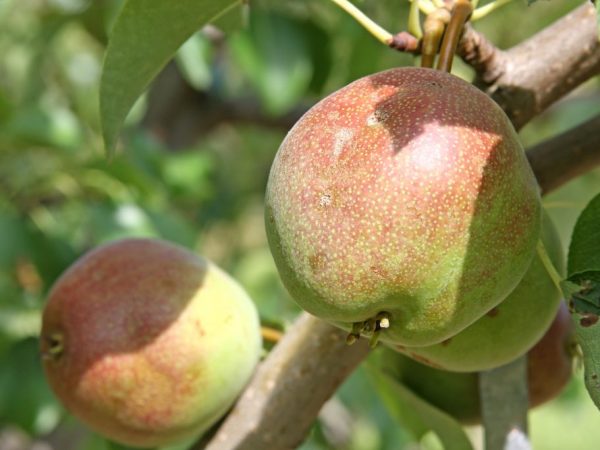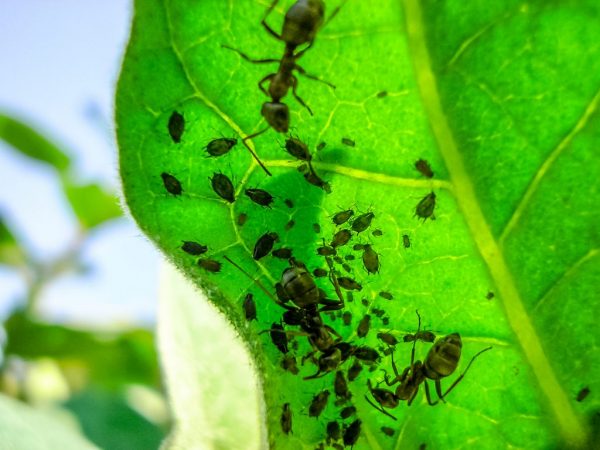Characteristics of the pear variety Rainbow
Pear Rainbow was bred in the Tambov region by selection and hybridization of the Lesnaya Krasavitsa variety. It is great for growing in the western, southwestern and southern parts of the country, as it was created for these conditions.

Characteristics of the pear variety Rainbow
Characteristics of the Rainbow variety
This variety is late, it tolerates winter well, withstands temperatures down to -38 ° C.
Rainbow, with proper care, pleases with fruits only for 5-6 years. According to the description, the variety has a high yield. The fruits are harvested in late September and early October. When stored in a cool room, the fruit lasts up to 3 months.
Description of the tree
The pear of the Rainbow variety is vigorous and has an oval crown with medium density, greenish-brown shoots. The buds, like most other varieties, are small, cone-shaped. Leaves of medium length, rounded, slightly shiny.
Pear varieties such as Yakovlevskaya and Nika become good neighbors: they perfectly pollinate each other. It is also permissible to plant apple trees nearby: they are actually the closest relatives.
Description of fruits
The sizes of the fruits of the Raduzhnaya variety, according to the description, are average or slightly above average. They have a weight of 130-170 g, an elongated shape. Their peel is oily, has a waxy coating.
Ripe fruits are greenish-yellow in color, with a straight, medium-length tail. Seeds are medium in size. The pulp is juicy, sweet in taste, impatient.
Care
The soil
Loose soil is best suited for this variety, allowing moisture and oxygen to pass through. When planting seedlings, a little clay is added to the soil, since it perfectly retains water at the root system of the tree.
A place
The place is chosen well lit and not sultry. The south, southwest side is great. For example, you can plant a tree behind your house.
The seedlings are planted in the fall. In winter, the tree is well insulated, sprinkled with snow or straw, young seedlings are wrapped with foil.
Landing
The top layer is removed from the pit and mixed with manure or peat. If the soil is acidic, add a little ash or lime. After that, the resulting mixture is poured back into the pit in such a way as to fill it to the brim.
A stake is driven into the middle and a seedling is placed there so that the root collar peeps out of the ground by 3-4 cm.The earth is tamped and watered abundantly with 15-20 liters of water. After the water is absorbed, the earth is mulched, then the tree is tied to a previously driven stake.
Watering

The tree is watered several times per season.
The ideal irrigation system is sprinkler irrigation, as the water also reaches the leaves. For these purposes, it is permissible to use a spray.
They also make a small ditch near the trunk circle and carefully pour water into it. After the soil is loosened. You need to water it several times in spring and summer. If there is a severe drought, the amount of water is increased.
Fertilization
When applying fertilizers, first of all, you need to pay attention to the state of health of the tree and the speed of its development.
Trees worth feeding:
- an annual tree with a shoot growth of 40 cm per year;
- a fruitful tree with a growth of shoots of 20 cm.
Fertilization, according to the description, is carried out exclusively from the second year.
The frequency of introducing organic and mineral substances:
- organic fertilizers - every 3 years (per 1 sq. m. - 9 kg of humus, 25 g of potassium chloride, 15 g of urea);
- mineral fertilizers - once a year.
It is better to first fertilize with phosphorus-potassium fertilizers, and pour organic fertilizers on top. Due to this, they will not evaporate from the surface of the earth.
Diseases
Pear variety Iridescent is unpretentious in care and resistant to many diseases. Despite this, with improper care, the tree can be affected by pests and diseases such as:
| Scab | Formed in spring. A bloom of greenish-gray color appears on the leaves, they soon fall off |
| Sooty fungus | Formation of black plaque on fruits and leaves. |
| Fruit rot | Formation of grayish-brown rot circles on the fruit. The spores of this disease are airborne, so other trees are more likely to be infected. |
| Rust | Fungus. Rust-like stains appear on the leaf. |
| Powdery mildew | It affects inflorescences, shoots, buds, leaves. It is accompanied by the appearance of a powdery off-white bloom, which soon turns into a brown color and forms black dots. |
Pests

The pear needs to be inspected regularly.
The pear is also not protected from insect attack. The most dangerous are leaf and fruit gall midges. These are small brown gnats, mainly feeding on leaves. After their appearance, small growths form on the deciduous part. To prevent the attack of these pests, it is recommended to treat the tree with insecticides in the spring. You also need to regularly inspect the leaves and remove the twisted ones. These are the nests of the gall midge.
Other equally dangerous pests include:
- honeydew;
- moth;
- gall mite;
- tick;
- bug;
- tube wrench;
- color beetle;
- silkworm
Causes of diseases
| Damage to the integrity of the tree |
|
| Thermal damage |
|
| Lack or excess moisture |
|
| Pest infestation |
|
| Parasites |
|
| Wrong diet |
|
It is worth paying considerable attention to the health of the tree, especially in the spring and autumn periods, since it is at this time that the pear is most susceptible to the attack of parasites and diseases.
Conclusion
Pear Rainbow is good because it has high resistance to frost. The advantage is also the ability of the fruit to keep for a long time.
The high disease resistance reduces the risk of tree loss. Untimely care, improper nutrition and the attack of various pests reduce the yield of the pear.


